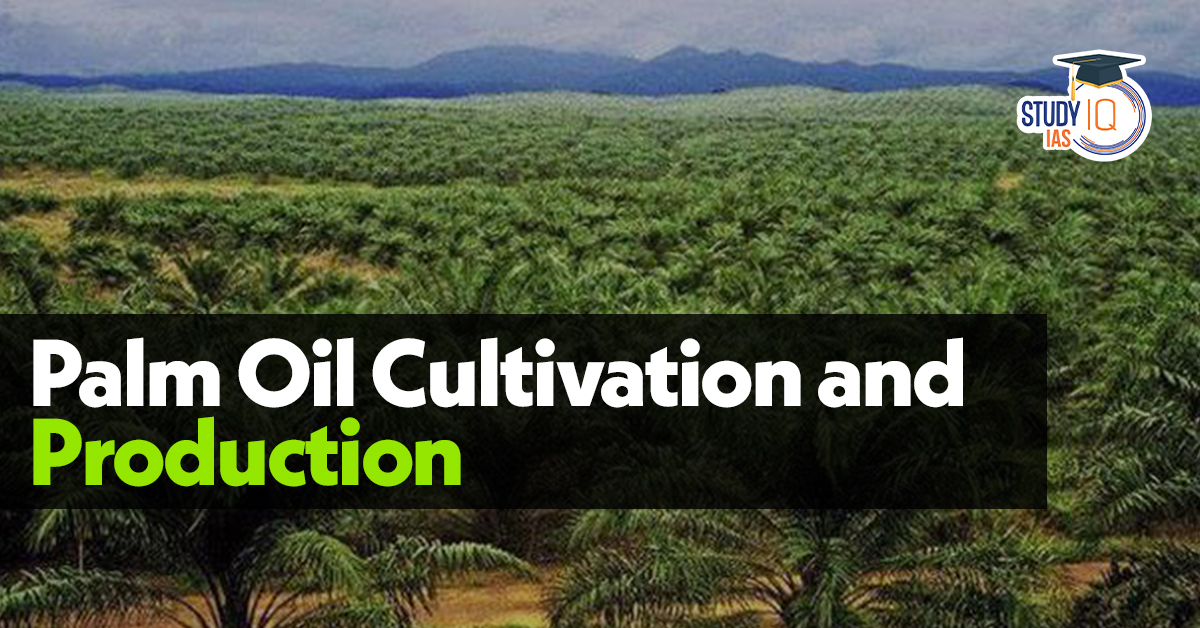Table of Contents
Context: Indonesia’s biodiesel push and stagnant production are driving up palm oil prices, impacting global vegetable oil markets and inflation.
Recent Situation of Palm Oil Production
- Slow Growth: Global production growth slowed to 1% annually over the past four years due to limited land and aging plantations.
- Biodiesel Push: Indonesia increased the mandatory mix of palm oil in biodiesel to 40% in 2024, reducing export availability.
- Deforestation Concerns: Environmental issues and land constraints in Indonesia and Malaysia are limiting new plantations.
- Labour Shortages: Malaysia faces a shortage of workers, slowing production.
- Ageing Plantations: Oil palms lose productivity after 20 years, but replanting is slow due to high costs and productivity loss during transition.
- Ganoderma Fungus: A fungal disease reducing yield and affecting palm health.
About Oil Palm (Elaeis guineensis)
- Origin: Comes from an African tree belonging to the palm family (Arecaceae).
- Global Distribution: Native to West and Central Africa, now widely cultivated in Malaysia and Indonesia.
- Nutritional Composition: Rich in beta-carotene, saturated and unsaturated fats, and vitamin E.
- Health Benefits: Used for preventing and treating vitamin A deficiency.
Conditions Suitable for Plantation
- Climate: Requires a hot and humid tropical climate (temperature between 30°C to 32°C).
- Rainfall: Annual rainfall of 250 cm to 400 cm.
- Soil: Deep, well-drained, fertile, loamy soil with a pH between 0 to 7.0.
- Altitude: Low altitudes, usually below 500 meters.
- Sunlight: Requires 5–7 hours of direct sunlight daily for optimal growth.
- Humidity: High humidity levels (at least 80%).
| Palm Oil Production |
National Mission on Edible Oils – Oil Palm (NMEO-OP)
|
Challenges Associated with Palm Oil Cultivation
- Deforestation and Habitat Loss: Palm oil cultivation is a major driver of tropical deforestation, especially in Southeast Asia (Indonesia and Malaysia).
- Since the 1960s, 60% of Borneo’s forests have been lost due to palm oil plantations.
- Forest loss threatens species like orangutans, Sumatran rhinos, and tigers, increasing their risk of extinction.
- Human-Wildlife Conflict: Habitat destruction forces animals to enter plantations in search of food.
- Orangutans, elephants, and other animals are often killed or injured by plantation workers trying to protect crops.
- Climate Change Contribution: Deforestation for palm oil contributes 2–4% of annual global greenhouse gas emissions.
- Peatland clearing for palm oil releases about 438 million tonnes of CO2 annually, equal to the emissions from EU vehicle traffic.
- Complex and Unregulated Supply Chains: Over 1,500 registered palm oil firms in Indonesia alone create a complex network of producers, processors, and distributors.
- Major corporations like Nestlé, PepsiCo, and Unilever have No Deforestation, No Peat, and No Exploitation (NDPE) commitments but struggle to enforce them.
- Illegal operations and weak enforcement undermine sustainability efforts.
- Illegal Clearing and Poor Regulation: Illegal logging and plantation establishment persist due to weak enforcement and corruption.
- Despite corporate commitments, sourcing from illegal plantations continues.
- Hidden Use in Products: Palm oil is present in over 200 derivative forms in everyday products (e.g., food, cosmetics, and cleaning supplies).
- The widespread and disguised presence of palm oil makes consumer awareness and accountability difficult.
- Soil Degradation and Water Scarcity: Palm oil requires large quantities of fertilizers and pesticides, leading to soil nutrient depletion.
- It is water-intensive (needs 250–300 litres per plant per day), straining local water resources.
- Loss of Indigenous Land and Community Rights: Large-scale plantations shift land control from indigenous communities to corporations.
- Local communities lose access to traditional lands and resources, impacting their livelihoods and food security.
| Palm Oil Cultivation Issues in Northeast India |
|
Sustainable Practices for Palm Oil Cultivation
- No Deforestation, No Peat, No Exploitation (NDPE) Policies: Ensure that palm oil is grown without deforestation, peatland destruction, or exploitation of communities.
- Use of Degraded Land: Plantations should be established on degraded or previously cultivated lands rather than primary forests.
- Water Management:
- Efficient Water Use: Implement systems to minimize water consumption and collect gray water for reuse.
- Protect Water Sources: Maintain riparian reserves to protect water quality and wildlife habitats.
- Waste Utilization: Reuse palm leaves and cuttings as mulch or compost.
- Optimized Fertilizer Use: Employ organic and bio-fertilizers based on soil tests to enhance fertility and reduce chemical dependency.
- Biodiversity Conservation
- Multi-Cropping: Intercrop with other plants to enhance biodiversity and provide additional income streams for farmers.
- Wildlife Corridors: Establish corridors within plantations to support local wildlife.
- Community Engagement: Obtain consent from local communities before establishing new plantations.
- Certification and Transparency: Adhere to Roundtable on Sustainable Palm Oil (RSPO) standards for transparency and accountability.


 Out-of-Pocket Health Expenditure, Reason...
Out-of-Pocket Health Expenditure, Reason...
 Treasury Bills (T-bills): RBI Cuts Holdi...
Treasury Bills (T-bills): RBI Cuts Holdi...
 Fisheries Sector in India, Current Statu...
Fisheries Sector in India, Current Statu...

























